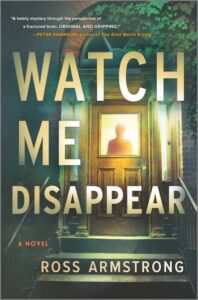In a sense, every detective novel is about the inside of someone’s head. What immediately captures the reader at the beginning of a Sherlock Holmes story is the tick-tock of Holmes mind: what brilliance will he conjure next, what detail will he pull out of an ordinary scene, who is this guy?
But we’ll come back to Holmes later, because the character of Tom Mondrian in Watch Me Disappear began to take shape alongside a more modern hero. I discovered one of my favourite series characters in a Majorcan villa when I picked a book off the shelf, curious to know why it was so dog-eared. What was it about this novel that meant it had been read so many times that many of its pages had fallen out and had been artfully Cello taped back to the inner spine? That was when I met the mind of Lee Child, and Jack Reacher. After one chapter I was forced to tell my friends: I will mostly just be reading this today.
I was no early adopter, Gone Tomorrow is Child’s 13th Reacher book, but it is unusual because it is told in the first person. We are allowed access to Jack’s head. In some ways it’s complex in there, in other ways Jack keeps things simple. The first chapter is a checklist as Reacher spots a woman on a train showing all the tell-tale signs of being a suicide bomber. The whole novel is shot through with a steady stream of revelations and violence. It’s full of post-9/11 paranoia, as if the towers fell that year, but it was 2009 when the book was published. Child shows us that within his tight and methodical thoughts, his deadpan humour, his willingness to fight at every opportunity, Reacher is a man with habits that might be coping mechanisms, a man concerned with people’s pasts and their secrets, because that’s where all the best trouble comes from.
What would a novel be like with a hero that has none of Reacher’s physical advantages, I wondered. In fact, what would a story be like that aimed to be just as propulsive as a Jack Reacher novel, but with a protagonist who was the opposite of Jack. An anti-Jack Reacher novel. This thought stuck fast to my cerebral cortex.
But it was years later that I saw Louis Theroux’s documentary A Different Brain, which tells the story of people’s lives, and personalities, forever altered by traumatic head injury. I was moved by how Theroux drew out what parts of these people had been lost, and I wondered about this new person that had emerged. What were their strengths, because we all see the world through a different lens, and I believe that no perspective is truer or better than any other.
Another year goes by. I read an article in my local newspaper about a trainee police officer who had been shot at with a sub machine gun on his first day on the beat in Hackney, London. The situation was so routine, the act of firing so strange and random, the fact the bullet missed was the only fortunate part of the story. But what, I wondered, if it hadn’t missed?
By then, I was researching something concrete. I went down Reddit holes, where you can, it turns out, find a surprising amount of people casually recounting being shot in the head and surviving. Then I read Oliver Sacks’ The Man Who Mistook His Wife for a Hat, a book of dizzying and mind-bending cases about very real traumatic brain injuries and their consequences. I ended up reading everything he’d ever written. I started to envision a book that was part Oliver Sacks, part True Detective, but set in North London.
I realised I had always been chasing writing a book like Chuck Palahniuk’s Fight Club. I saw it as a kind of coming-of-age paranoia thriller. A book about trying to find a way of looking at the world when no ideology fits – not nihilism, not capitalism, not socialism – meaning the only answer is for the narrator to try to get to know themselves. And in this modern age of fractured minds – overworked and distracted – that is easier said than done.
I had always loved Christopher Nolan’s film Memento too, and it seemed to me that this could help. The central character has an unusual problem, much like in SJ Watson’s Before I Go To Sleep: Each new day, the protagonists can never remember the events of the day before. It’s not just a brilliant conceit, it can only be achieved with real commitment to telling the story in the first person. Therefore, the story can feel honest in keeping the reader at arm’s length about what they need to know, plus the process of the character’s discoveries cannot be of greater importance; it’s not only about saving their own lives, but about finding out whose life that is exactly. It’s an idea that fascinates me still: we’re all born or acquire beautiful strengths and limitations, and we’re on a constant voyage of discovery to figure out what they are, and who we are.
It was only after writing the novel that I began to realise it shared similar DNA with Jonathan Coe’s The Curious Incident of the Dog in the Night-Time, which begins with young Christopher Boone, still traumatised by his mother’s death, finding his neighbour’s dog stabbed with a garden fork. His need to know, his drive, his unorthodox methods, yes, he could work with Tom Mondrian. Together, they might give Jack Reacher a run for his money.
In many ways, whenever I pick up a novel, I am looking to be transported into someone’s head, and so I very often enjoy those books that put you right there, and even better if it’s with someone whose whole outlook is utterly singular. Most recently in this vein, I enjoyed Catriona Ward’s The Last House on Needless Street. It’s a wild ride that goes to some dark, horror-inflected places, as these stories about the inner working of the brain can tend to do. But you want to spend time with these characters, because there’s warmth and originality in their perspective, and that’s what I hope Tom Mondrian has too.
All of this strikes at the heart of what I loved as a kid about Barry Levinson’s Young Sherlock Holmes. This was my first interaction with the Holmes character. I loved meeting him before he had achieved anything, I loved watching him in the slow act of becoming who he was. I am sure the purists will tell me this film doesn’t fit into the agreed biography of Holmes, but I can still picture him next to the frozen River Thames. It’s only as I write this that I realise that image that lodged itself in my brain is probably why I set the story in a snowy Winter London. It seemed a perfect landscape for a detective story about the mind, everything frozen in a state where it can be analysed. Or else, slowly thawing, like the character of Tom Mondrian himself, as he recovers from his traumatic injury, parts of his past obscured, new parts of him awakened, longing for meaning in a cold, cold climate.
***


















